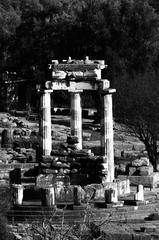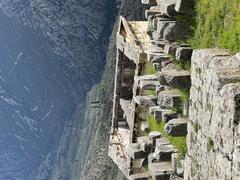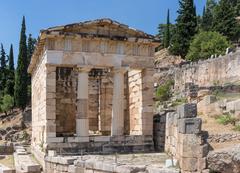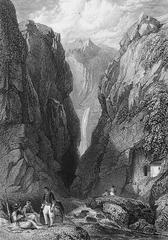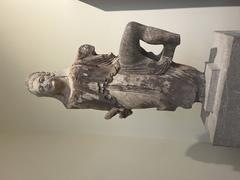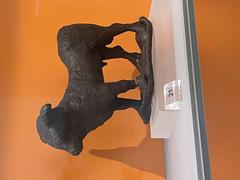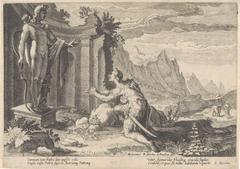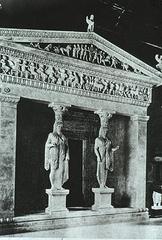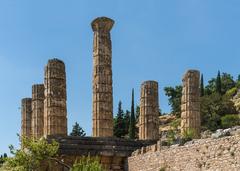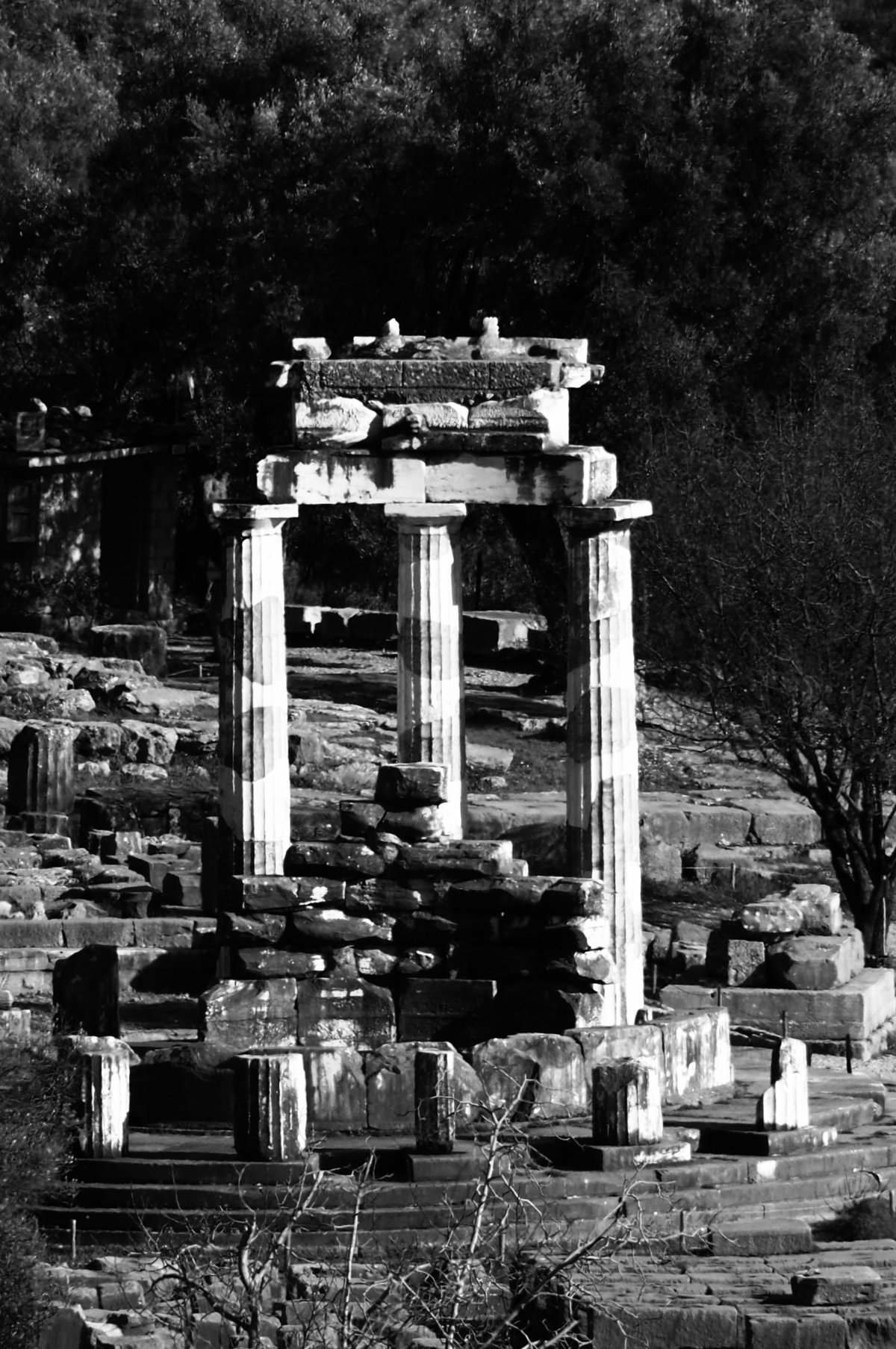
Tholos of Delphi: Visiting Hours, Tickets, and Historical Significance Guide
Date: 15/06/2025
Introduction
The Tholos of Delphi is one of the most remarkable and enigmatic monuments of ancient Greece, captivating visitors with its unique circular architecture and profound cultural significance. Located within the Sanctuary of Athena Pronaia at Delphi, it dates back to approximately 390–360 BCE, during the height of Classical Greece. Unlike the more common rectangular temples, the Tholos’s circular design—with a peristyle of 20 Doric columns and an inner ring of Corinthian columns—showcases advanced engineering and pioneering aesthetics that influenced Greek and Roman architecture for centuries (marble.nd.edu; Culture Activities).
Delphi itself was a revered religious and cultural center, home to the famous Oracle of Apollo and regarded as the “navel of the world” by the ancient Greeks. The placement of the Tholos within the Sanctuary of Athena Pronaia marked a symbolic gateway from the ordinary to the sacred, with architectural elements imbued with cosmological and ritual meaning (greekmythologytours.com; greekhistoryhub.com).
For modern visitors, the Tholos offers not only insight into ancient religious practices and exceptional artistry but also breathtaking panoramic views of Mount Parnassus and the surrounding valley. This guide provides essential information on the Tholos’s history, architectural features, visiting hours, ticketing, accessibility, and nearby attractions, ensuring a rich and memorable experience (delphi.culture.gr; wildtrips.net).
Contents
- Introduction
- Origins and Historical Context
- Architectural Design and Features
- Layout and Materials
- Decorative Elements
- Structural Innovations
- Function and Significance
- Religious and Ritual Role
- Artistic and Architectural Influence
- Archaeological Remains and Restoration
- Visiting the Tholos of Delphi
- Hours and Ticket Information
- Accessibility and Visitor Tips
- Guided Tours and Nearby Attractions
- Photo Opportunities
- Frequently Asked Questions (FAQ)
- Conclusion
- Sources and Further Reading
Origins and Historical Context
The Tholos of Delphi stands as an architecturally significant and enigmatic monument within the Sanctuary of Athena Pronaia at Marmaria, about 800 meters southeast of the main Temple of Apollo. Built around 390 BCE, it reflects the wealth and ambition of Delphi during the late 5th and early 4th centuries BCE (marble.nd.edu; wildtrips.net). Delphi was already a major religious center, renowned as the seat of the Oracle of Apollo and a hub for pan-Hellenic pilgrimage, prophecy, and political counsel (greekreporter.com; greek.mythologyworldwide.com).
Originally, the sanctuary was dedicated to Gaia, the primordial earth goddess, before transitioning to Athena Pronaia (“Athena before the temple”), guardian of the main Apollo sanctuary (greek.mythologyworldwide.com). The creation of the Tholos reflects a period of innovation and spiritual significance.
Architectural Design and Features
Layout and Materials
The Tholos of Delphi is a rare example of a circular temple, or tholos, in Classical Greek architecture (britannica.com). Designed by Theodoros of Phokaia, it was built primarily from Pentelic marble—the same as the Parthenon. The building originally measured about 13.5 meters in diameter.
A peristyle of 20 slender Doric columns formed the exterior, with an inner ring of 10 Corinthian columns—one of the earliest and most influential uses of the Corinthian order (marble.nd.edu). This blend of architectural styles became a model for later Greek and Roman buildings.
Decorative Elements
The Tholos was richly decorated. Its external Doric frieze and cella wall featured 80 sculpted metopes, though only fragments survive (marble.nd.edu). The marble roof was adorned with acroteria (statues) and a double gutter system with lion-head spouts and acanthus scrolls, a feature later popular at sites like Epidauros.
Inside, between the Corinthian columns, were likely nine chryselephantine (gold and ivory) statues—now lost. Modern research, including 3D modeling, has helped reconstruct hypotheses about the original roof and its engineering (springer.com).
Structural Innovations
The Tholos’s circular plan required advanced engineering. Its foundations consisted of concentric stone rings, supporting the weight of a heavy marble-tiled roof. The combination of Doric and Corinthian columns was innovative and helped popularize the Corinthian order. The slender Doric columns at Delphi marked a transition toward more refined classical forms (marble.nd.edu).
Function and Significance
Religious and Ritual Role
The Tholos’s exact function is debated. It was certainly a sacred building, possibly used for rituals dedicated to Athena Pronaia or as a meeting place for significant religious or political activities (wildtrips.net). Some scholars suggest it played a role in preparatory rites for those seeking the Oracle or was used for hero worship or mystery cults. Its position at the sanctuary entrance underscores its role as a symbolic threshold (odynovotours.com).
Artistic and Architectural Influence
The Tholos’s ornate design set a new standard for sacred architecture in Greece after the Parthenon, inspiring later circular buildings at Epidauros, Olympia, and Samothrace (britannica.com). Its use of the Corinthian order and decorative gutters became hallmarks of later Greek and Roman architecture. The building’s harmonious proportions and geometry reflect the Greek cosmological vision and ideals of order and beauty (springer.com).
Archaeological Remains and Restoration
Today, three of the original 20 Doric columns have been re-erected, making the Tholos one of Delphi’s most iconic ruins (odynovotours.com). The base, cella wall fragments, and scattered sculptural elements are visible on site. Restoration by the French School at Athens in 1938, which re-erected part of the Tholos, allows visitors to appreciate its scale.
Fragments of the sculpted metopes and roof tiles are displayed in the Delphi Archaeological Museum (wildtrips.net). Ongoing research, including digital modeling, continues to reveal new insights into its construction and original appearance (springer.com).
Visiting the Tholos of Delphi
Hours and Ticket Information
- Summer (April–October): 8:00 AM to 8:00 PM
- Winter (November–March): 8:00 AM to 5:00 PM
Hours may vary with the season and special events; check official Delphi visitor information before visiting.
Tickets
Admission to the Tholos is included in the general ticket for the Delphi archaeological site, which also covers the museum and other monuments. As of 2025, tickets are €12 for adults, with reductions for EU citizens aged 18–25 and free entry for children under 18 and seniors over 65. Combined tickets are available, and online purchase is recommended during peak periods.
Accessibility and Visitor Tips
Paths around the Tholos are uneven and can be steep. Wear sturdy shoes and bring water and sun protection. The site is partially accessible; those with mobility challenges should contact the site in advance for assistance. Early morning or late afternoon visits offer cooler temperatures and optimal lighting for photography.
Guided Tours and Nearby Attractions
Guided tours are highly recommended for understanding the Tholos’s history and architecture. Tours often include the Sanctuary of Apollo, the Castalian Spring, and the Delphi Archaeological Museum. The panoramic view from the Tholos offers some of the best photo opportunities in the region.
Frequently Asked Questions (FAQ)
Q: What are the Tholos of Delphi visiting hours?
A: Open 8:00 AM–8:00 PM (April–October), 8:00 AM–5:00 PM (November–March). Always check official sources for updates.
Q: How do I buy tickets?
A: Tickets are available on-site and online as part of the Delphi archaeological site admission.
Q: Is the Tholos accessible to people with disabilities?
A: Some areas are challenging, but assistance is available. Contact site management for specific details.
Q: Are guided tours available?
A: Yes, both local and Athens-based operators offer guided tours, which are recommended.
Q: What other sites are nearby?
A: The Sanctuary of Apollo, Delphi Archaeological Museum, and Castalian Spring are all within walking distance.
Responsible Visiting and Preservation
- Stay on marked paths and respect barriers.
- Avoid touching or climbing on ruins.
- Use provided bins for waste; consider carrying your trash out.
- Support conservation by following site rules and considering donations.
- Engage with educational materials, tours, and audio guides to enhance your visit.
Ongoing preservation, including digital reconstructions and academic study, ensure the Tholos will inspire future generations.
Summary and Recommendations
The Tholos of Delphi is a testament to the innovation, artistry, and spirituality of ancient Greece. Its unique circular design, blending Doric and Corinthian orders, and rich decorative details have inspired generations. Understanding its history and planning your visit—considering hours, tickets, accessibility, and guided tours—will enhance your appreciation of this extraordinary monument. Combine your visit with the Temple of Apollo and the Delphi Archaeological Museum for a comprehensive experience of Delphi’s spiritual and artistic legacy (marble.nd.edu; delphi.culture.gr; Culture Activities; wildtrips.net).
Sources and Further Reading
- Tholos of Delphi: Visiting Hours, Tickets, and Guide to This Iconic Historical Site, 2025
- Tholos of Delphi: Architectural Marvel, Visiting Hours, and Ticket Information, 2025
- Tholos of Delphi: Visiting Hours, Tickets, and Cultural Significance of Delphi’s Iconic Monument, 2025
- Tholos of Delphi: Visiting Hours, Tickets, and Preservation Guide for Exploring Delphi’s Historical Site, 2025
- Ancient Greek Oracle Delphi, 2024
- The Cultural Significance of Delphi: A Nexus of Ideas, 2024
- Delphi Ancient Ruins and Mythology, 2025
- Delphi’s Sacred Landscape: The Geographical and Spiritual Importance of the Site, 2025
- Tholos of Delphi: Structural and Architectural Analysis, 2025
- Official Delphi Site Visitor Information, 2025
